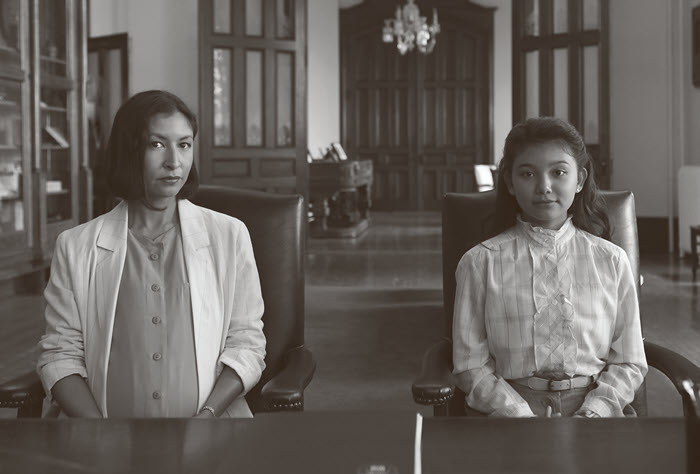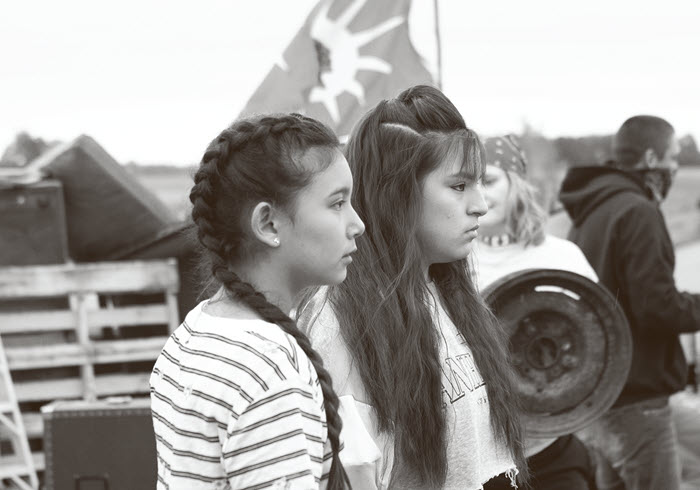Corps de l’article
Inspired by her own childhood experiences, Director Tracey Deer’s 2020 film Beans chronicles the Oka Crisis of 1990 from the perspective of Kahnawa’kehró:non (Kahnawá:ke Mohawks). Beans captures a life-changing time in Kahnawá:ke when the community became associated with armed conflict, tanks, barbed wire, and barricades. Using both archival footage and dramatic re-enactments, Deer showcases the truth of the trauma and violence that many Kahnawa’kehró:non still carry with them today. Beans is a chance for Kahnawa’kehró:non to present their memory of events.
Beans is a coming-of-age film that follows 12-year-old Tekehentahkhwa “Beans” (Kiawentiio Tarbell) through the summer of 1990 – a summer that would teach Beans about racism, rage, friendship, family, and young adulthood. Most coming-of-age films deal with the loss of innocence, usually in the context of interpersonal relationships, in the transition to adulthood, and this film is no different. Beans learns some hard lessons about acting more grown-up than she is, and she gets herself into some dangerous situations during her quest to “toughen up.” However, Deer went beyond this usual trope, incorporating additional losses of childhood innocence about safety, cultural difference, and the realities of anti-Indigenous racism in Canada.
Beans, a bubbly, sweet overachiever, learns while watching assaults on her family and community that some people will hate you just for being Indigenous. Initially, she feeds into that hate and replicates it when she falls in with a tough, older girl named April (Paulina Alexis), who teaches Beans that “if you can’t feel pain, no one can hurt you.” April discourages Beans from attending an off- reserve private school, showing anger and contempt for that “white school.” When the film introduces Beans, she is at an interview for that private school. Beans slowly repeats her name, Tekehentahkhwa, to the principal until she gives up and offers her nickname, Beans, to make it easier. This scene feels real, and it portrays an experience that many young Indigenous people with traditional names have. The discomfort on her mother’s face as Beans compromises her identity shows just how naive Beans is at the start of the story and how much Beans wants others to like her as someone she is not.
Looming in the background are the increasing tensions at the Pines in Kanesatake, tensions that first appear on a television screen in the family living room. In this scene, Deer cuts one of the actors into archival footage, blending the footage almost seamlessly into the fictionalized dramatization. Some critical responses to Beans note that the story focus shifts from the coming-of-age narrative to the broader issue of the Oka Crisis.[1] However, as Deer shows in this transition, in the lives of Indigenous people, political conflicts and responses of resistance are not separate from everyday life: they are all connected.
A pattern of innocent joy followed by crushing reality is threaded throughout Beans. The plot follows Beans and her sister Ruby (Violah Beauvais) as their mother, Lily (Rainbow Dickerson), takes them to the protest camp – a journey Ruby dubs a “road trip.” The Pines protest camp is full of women, children, food, and laughter. This protest camp is similar to any Indigenous-led camp we would see today. Beans and Ruby, affectionately known as Ru, are unaware of the danger of the situation. Like the rest of the camp, they are not there for violence but to take up space on their lands and protect their ancestors’ territory and sacred burial grounds – which Beans and Ru stumble upon while searching for firewood. The girls begin to clean up the golf balls littered among the tombstones, and they gather wildflowers to place on the graves in the quiet of the Pines. A shot rings out, and then another. The girls run back through the camp with gunshots, tear gas, and concussion grenades going off all around them. It is jarring against the quiet of the previous scene. The audience can feel the anxiety and fear of people who were peaceful just moments before – people who brought their children to the land in peace.
figure 1
On the way back to Kahnawá:ke, the car radio plays an archival news broadcast about the altercation they had been right in the middle of and the death of a Sûreté du Québec (SQ) officer. Beans realizes that this is a much more dangerous situation than she had thought. We see this pattern again in other shocking scenes, after Ru complains about her lunchtime oatmeal as white protesters prevent food trucks from coming to Kahnawá:ke grocery stores. Lily decides to take a boat to get around the barricades. Beans, Ru, and their cousins are excited to get to the grocery store and leave the reserve, and there is a sense of optimism on the boat. But the manager denies them service when they attempt to pay for their groceries, and French-speaking bystanders yell slurs and obscenities at them as they go. Outside are more angry white people, including a man who spits on them as they board their boat. Before the audience can pass this off as a pure dramatization, Deer inserts archival clips of the Route 132 barricade and angry white mobs at grocery stores, who justified their actions by claiming that the Mohawks were the terrorists. The audience can feel the hate grow for both the whites and Beans as the Oka Crisis drags on and the family faces worsening racial and physical assaults. But there are moments when women in the community, in true Mohawk matriarchal fashion, show Beans that meeting violence and hate with the same is not the correct response. When the conflict is over, and all the anger dissipates, we see a different Beans: a strong young woman who proudly calls herself Tekehentahkhwa.
figure 2
L–R, Violah Beauvais as Ruby and Kiawentiio as Beans in Beans. Photo by Sebastien Raymond.
Archival footage plays a significant role in Beans. Deer’s use of this footage is a nod to her documentarian style and her desire to support her dramatized scenes with references. It is there to support the story and set the stage beyond the ’90s costume aesthetic. Deer uses archival footage to convey the realities of the Oka crisis for Kahnawa’kehró:non. Through the dramatized elements of the film, we see Kahnawá:ke from the inside, with Beans, her friends, and her family. The archival footage shows us the chaos brought to their doorstep. Deer uses archival footage in ways that counter its intended purpose, which was to evoke sympathy for the frustrated Québécois and portray Kahnawa’kehró:non as dangerous protestors who required military intervention. The film’s use of settler-created archival footage for the purposes of Indigenous storytelling shows us new ways that archivists can explore and reinterpret provenance. Archivists hold provenance to be an integral piece of the record, the context for its creation, and therefore, a factor in how it is perceived, accessed, and described.[2] The complex nature of settler-created – more specifically, media-created – records around the Oka Crisis, like those found in Deer’s film, can teach us a lot about the intersecting conceptualizations of provenance. Archivists and archival repositories that expand their understandings of provenance and of the implications of the records they hold could transform the use of these records for Indigenous Peoples.[3] Settlers created many of the records contained in Canada’s colonial archives without the consent or voices of the Indigenous Peoples they objectified. Deer chose archival news footage showing white Canadians wishing for the deaths of Indigenous people and rioting in the streets because Mohawks denied them access to the Mercier Bridge. Projects like Beans show how creators can inject archival records and memories into dramatizations to tell stories that may not be true but feel like they could have happened.
In Kahnawá:ke, people still remember being denied service at grocery stores, being spat on, being the targets of angry whites throwing rocks at families, and having the National Guard and SQ restrict their movements. Books like Leanne Betasamosake Simpson’s This Is an Honour Song illustrate the powerful impacts felt across Indigenous nations from this 78-day resistance. Beans is a complex film that takes on more than a coming-of-age story. Deer has translated to the screen a moment of transition, when Indigenous girls realize how unfair Canada is and how dangerous the world can be – even in their own community. It is a film that may be set more than 30 years in the past but that echoes the modern struggles of today, especially when we think of ongoing resistance to the development of pipelines through traditional territories and of violence against Indigenous women and girls. The use of archival audiovisual records further brings home the legacy of a summer forever cemented into the minds of Indigenous nations across what settlers call Canada. While this film is not an in-depth history of the Oka Crisis, it is an authentic look into how families on the Kahnawá:ke side of the barricades faced more than the racial hate that surrounded them on all sides.
figure 3
Parties annexes
Notes
-
[1]
In a review for the media site Battle Royale with Cheese, Ray Lobo says, “The mixing of a political event with a coming-of-age teenage story just does not work.” Ray Lobo, “Beans: Review,” BRWC, November 5, 2021, https://battleroyalewithcheese.com/2021/11/beans-review/.
-
[2]
Tom Nesmith, “The Concept of Societal Provenance and Records of Nineteenth-Century Aboriginal–European Relations in Western Canada: Implications for Archival Theory and Practice,” Archival Science 6, no. 3–4 (May 2007): 351–360, 352, https://doi.org/10.1007/s10502-007-9043-9.
-
[3]
Nesmith, 352.
Liste des figures
figure 1
figure 2
figure 3




